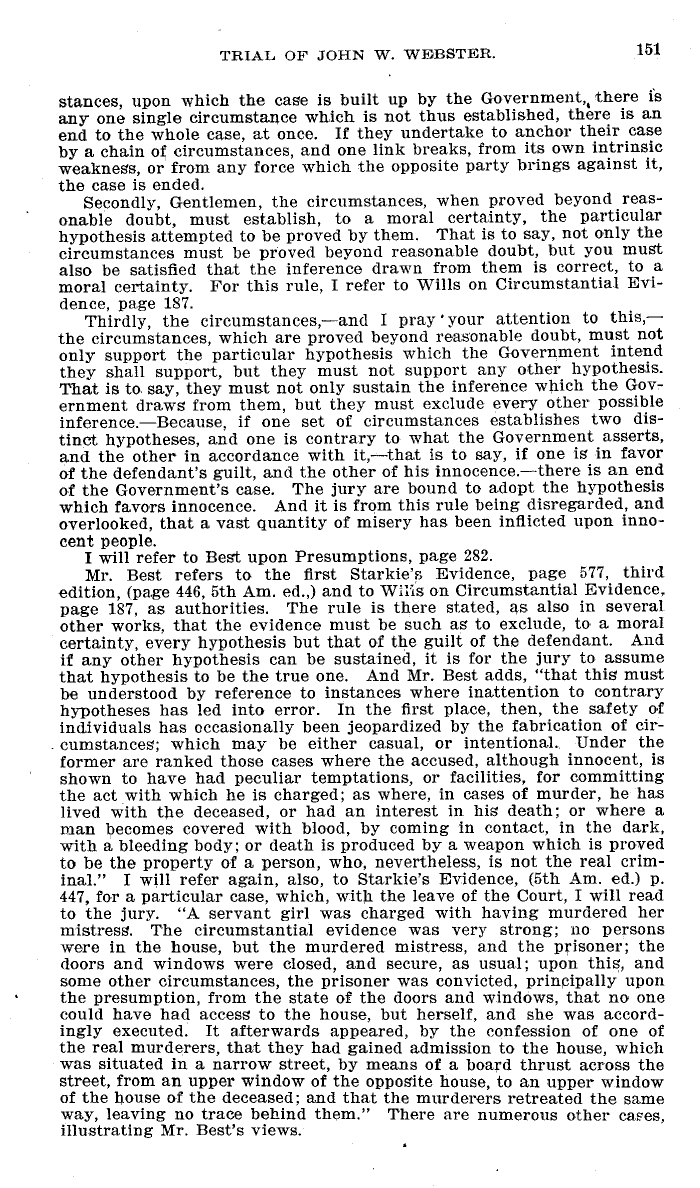|
TRIAL OF JOHN W. WEBSTER. 151
stances, upon which the case is built up by the Government, there is
any one single circumstance which is not thus established, there is an
end to the whole case, at once. If they undertake to anchor their case
by a chain of circumstances, and one link breaks, from its own intrinsic
weakness, or from any force which the opposite party brings against it,
the case is ended.
Secondly, Gentlemen, the circumstances, when proved beyond reas-
onable doubt, must establish, to a moral certainty, the particular
hypothesis attempted to be proved by them. That is to say, not only the
circumstances must be proved beyond reasonable doubt, but you must
also be satisfied that the inference drawn from them is correct, to a
moral certainty. For this rule, I refer to Wills on Circumstantial Evi-
dence, page 187.
Thirdly, the circumstances,-and I pray'your attention to this,-
the circumstances, which are proved beyond reasonable doubt, must not
only support the particular hypothesis which the Government intend
they shall support, but they must not support any other hypothesis.
That is to, say, they must not only sustain the inference which the Gov-
ernment draws from them, but they must exclude every other possible
inference.-Because, if one set of circumstances establishes two dis-
tinct hypotheses, and one is contrary to what the Government asserts,
and the other in accordance with it,-that is to say, if one is in favor
of the defendant's guilt, and the other of his innocence.-there is an end
of the Government's case. The jury are bound to adopt the hypothesis
which favours innocence. And it is from this rule being disregarded, and
overlooked, that a vast quantity of misery has been inflicted upon inno-
cent people.
I will refer to Best upon Presumptions, page 282.
Mr. Best refers to the first Starkie's Evidence, page 577, third
edition, (page 446, 5th Am. ed.,) and to Wils on Circumstantial Evidence,
page 187, as authorities. The rule is there stated, as also in several
other works, that the evidence must be such as to exclude, to a moral
certainty, every hypothesis but that of the guilt of the defendant. And
it any other hypothesis can be sustained, it is for the jury to assume
that hypothesis to be the true one. And Mr. Best adds, "that this must
be understood by reference to instances where inattention to contrary
hypotheses has led into error. In the first place, then, the safety of
individuals has occasionally been jeopardized by the fabrication of cir-
cumstances; which may be either casual, or intentional., Under the
former are ranked those cases where the accused, although innocent, is
shown to have had peculiar temptations, or facilities, for committing
the act with which he is charged; as where, in cases of murder, he has
lived with the deceased, or had an interest in his death; or where a
man becomes covered with blood, by coming in contact, in the dark,
with a bleeding body; or death is produced by a weapon which is proved
to be the property o-f a person, who, nevertheless, is not the real crim-
inal." I will refer again, also, to Starkie's Evidence, (5th Am. ed.) p.
447, for a particular case, which, with the leave of the Court, I will read
to the jury. "A servant girl was charged with having murdered her
mistress. The circumstantial evidence was very strong; no persons
were in the house, but the murdered mistress, and the prisoner; the
doors and windows were closed, and secure, as usual; upon this, and
some other circumstances, the prisoner was convicted, principally upon
the presumption, from the state of the doors and windows, that no one
could have had access to the house, but herself, and she was accord-
ingly executed. It afterwards appeared, by the confession of one of
the real murderers, that they had gained admission to the house, which
was situated in a narrow street, by means of a board thrust across the
street, from an upper window of the opposite house, to an upper window
of the )Louse of the deceased; and that the murderers retreated the same
way, leaving no trace behind them." There are numerous other cases,
illustrating Mr. Best's views.
|

